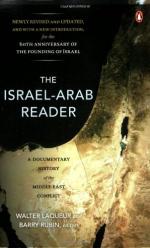
|
| Name: _________________________ | Period: ___________________ |
This test consists of 15 multiple choice questions and 5 short answer questions.
Multiple Choice Questions
1. Who supported the peace proposals of President Habib Bourguiba and King Fahd?
(a) The 14th Arab Summit.
(b) The 13th Arab Summit.
(c) The 15th Arab Summit.
(d) The 12th Arab Summit.
2. Whom should be included in any peace negotiation, according to Boutros Bpoutros-Ghali?
(a) Egypt.
(b) The PLO.
(c) USSR.
(d) The United States.
3. Who was President of the United States in 1993?
(a) Bill Clinton.
(b) Ronald Regan.
(c) Al Gore.
(d) George Bush Senior.
4. Why did Egypt adopt the cease fire of 1973, according to Sadat in Part IV pp 202-340?
(a) Egypt was pressured by the USSR.
(b) Egypt got back the territories previously lost.
(c) Egypt was not prepared to fight the U.S.
(d) Egypt lost his main army corp.
5. Who was the Israeli defense minister in December, 1981?
(a) Karl Kramer.
(b) Ariel Sharon.
(c) Maurice Studd.
(d) Joseph alenberg.
6. What does Shamir refuse to do?
(a) Recognized with the PLO.
(b) Negotiate with the PLO.
(c) Negotiate with Jordan.
(d) Negotiate with Egypt.
7. Who gave speeches at the Madrid Peace Conference?
(a) Prime Minister Yitzhak Shamir and Arafat.
(b) Prime Minister Yitzhak Shamir and Clinton.
(c) Prime Minister Yitzhak Shamir and Haydar Abd al-Shafi
(d) Prime Minister Yitzhak Shamir and Bush.
8. What problems did Kedouri examine?
(a) Problems between U.S and Egypt.
(b) Problems between the PLO and other Arab organizations.
(c) Problems between the PLO and Israel.
(d) Problems between Arab and Israelis.
9. What issues does Y. Harkabi address in Part IV pp. 340-382?
(a) Dictatorial Palestinian State.
(b) Monarchist Palestinian State.
(c) Communist Palestinian State.
(d) Democratic Palestinian State.
10. What was Boutros Bpoutros-Ghali's role according to Part V pp 430-477?
(a) Egypt Foreign Minister.
(b) Egypt Vice President.
(c) Egypt Ministry of State.
(d) Egypt Army Chief.
11. When did King Hussein speak to the Palestine National Council and say that Palestine was still the top priority?
(a) November, 1985.
(b) November, 1984.
(c) November, 1983.
(d) November, 1986.
12. When did Yasir Arafat and Yitzhak Rabin sign an agreement?
(a) September 9, 1995.
(b) September 9, 1994.
(c) September 9, 1990.
(d) September 9, 1993.
13. When did President Asad of Syria state that the PLO had reached a secret agreement with Israel without the other Arab states being involved in the months of secret negotiations?
(a) October 1, 1993.
(b) October 1, 1990.
(c) October 1, 1991.
(d) October 1, 1992.
14. What summit created a military relaxation between America and USSR?
(a) Nixon-Brezhnev.
(b) USSR Summit.
(c) Geneva Summit.
(d) Madrid Summit.
15. What made Arab organizations look good?
(a) Elections.
(b) The term "democratic state."
(c) Refugee camp.
(d) The killing of civilians by Israel.
Short Answer Questions
1. What was the new Israeli government willing to do for peace?
2. Where did Israel gain land in during the Yom Kippur War?
3. What did the Popular Front for the Liberation of Palestine refuse to take part in?
4. When was Yitzhak Rabin inaugurated?
5. Why was the Agranat Commission created?
|
This section contains 477 words (approx. 2 pages at 300 words per page) |

|




